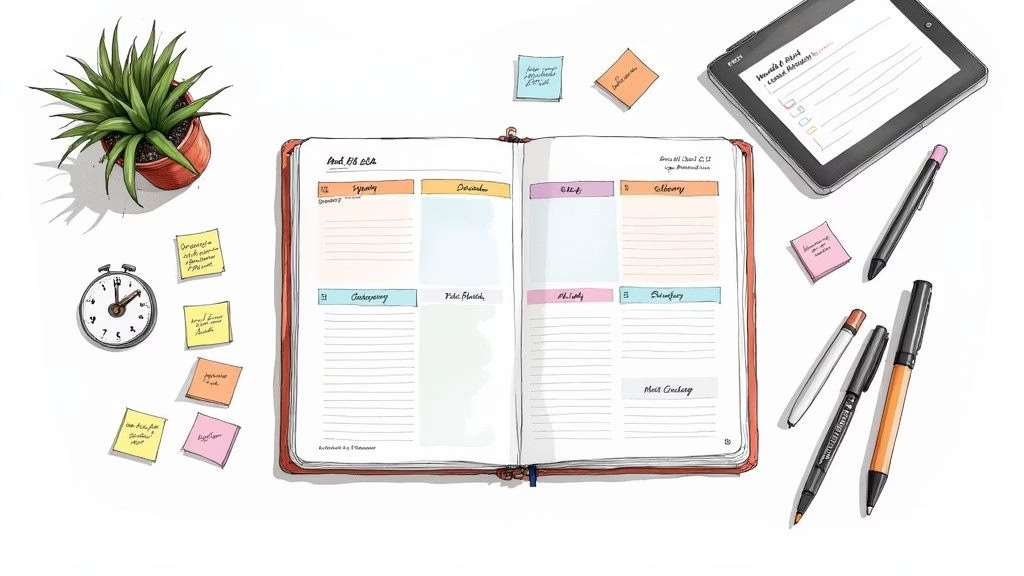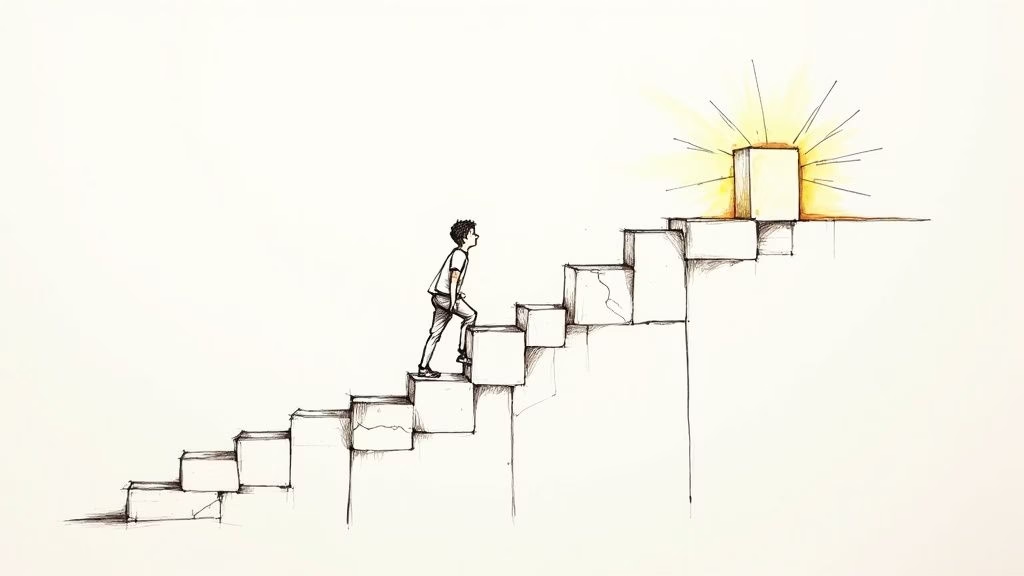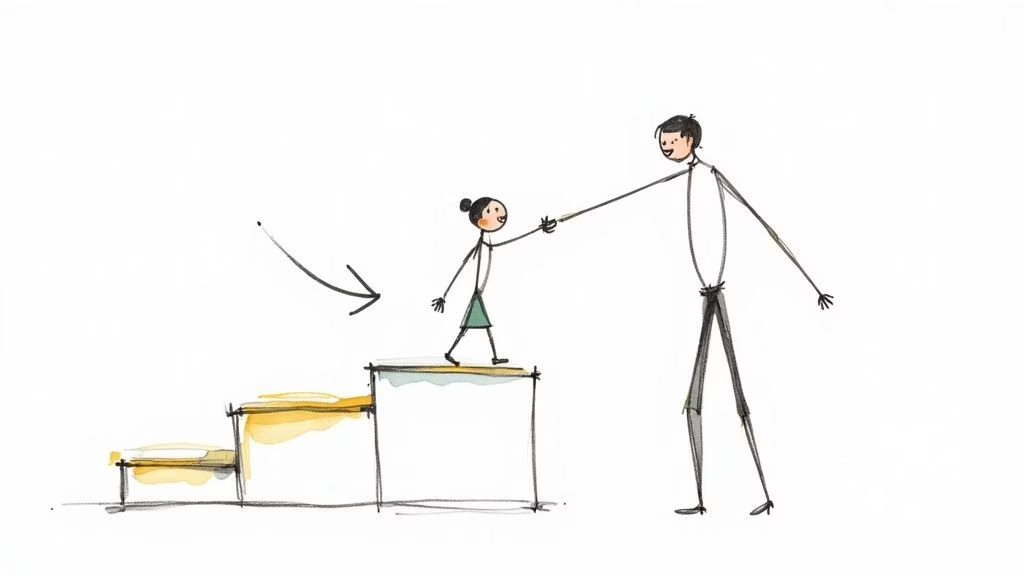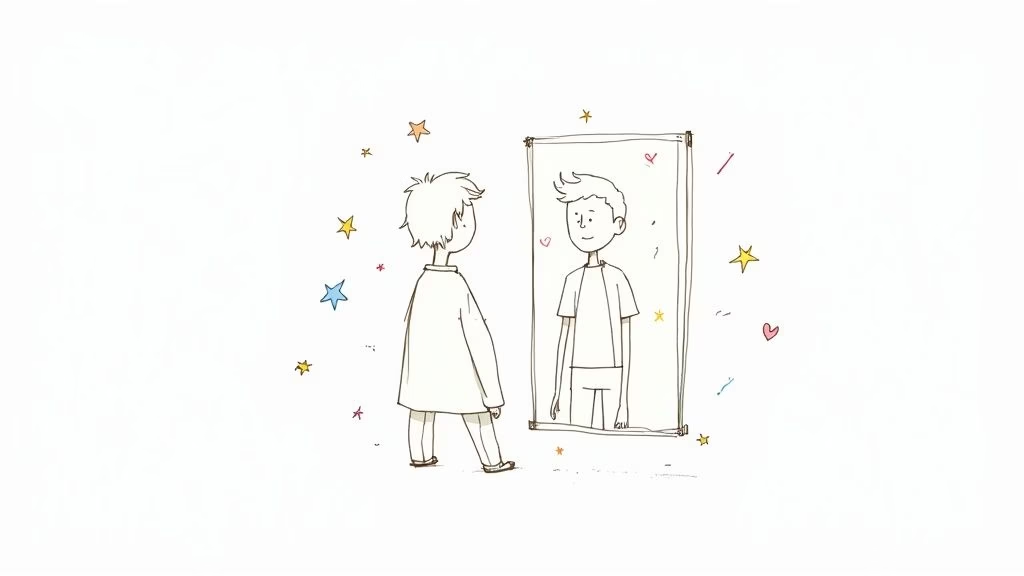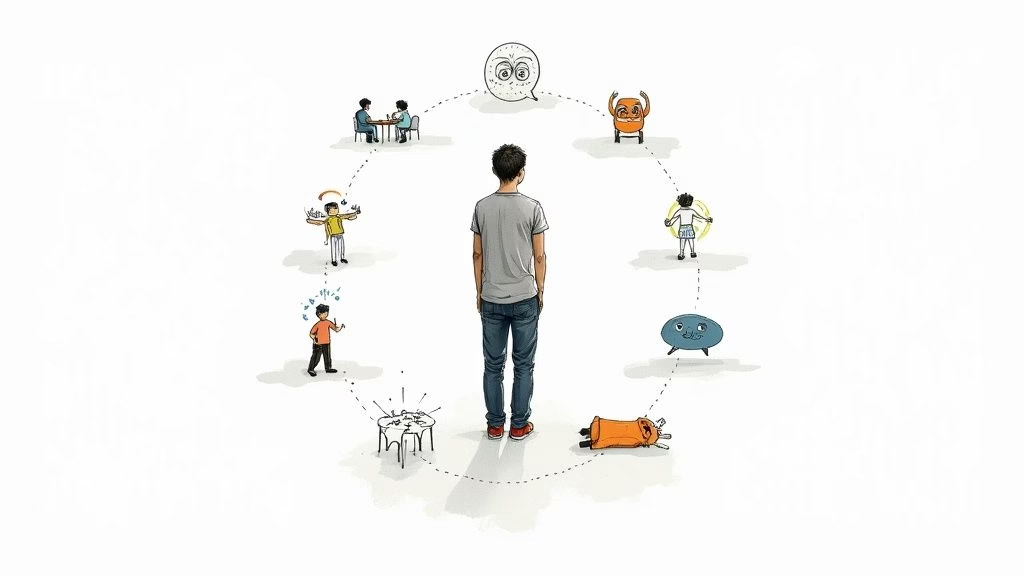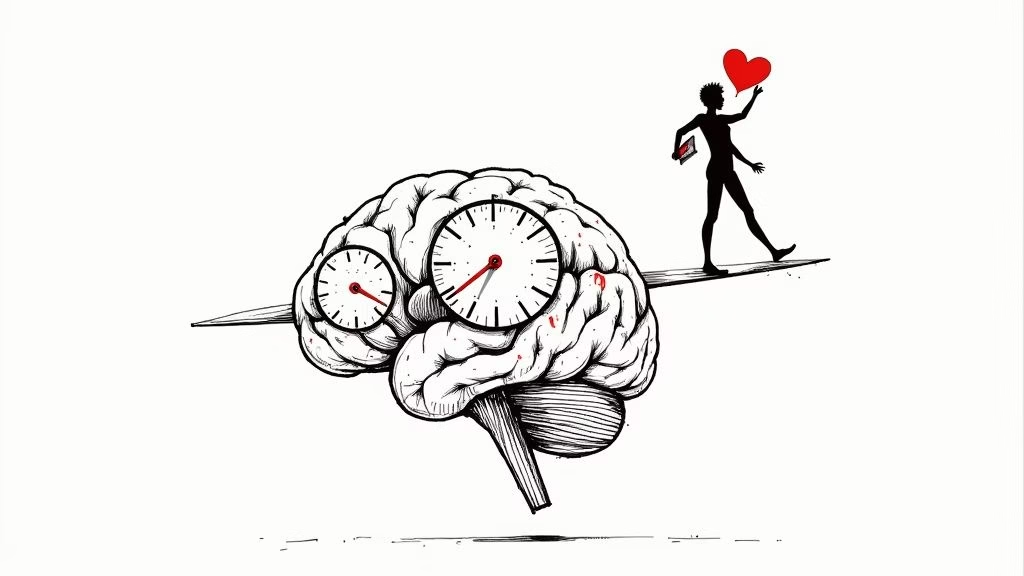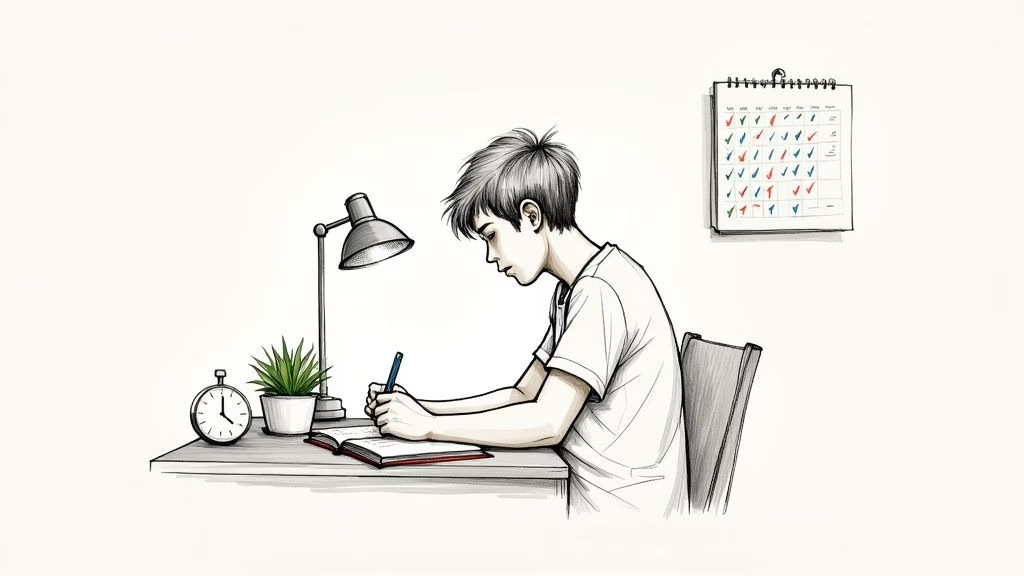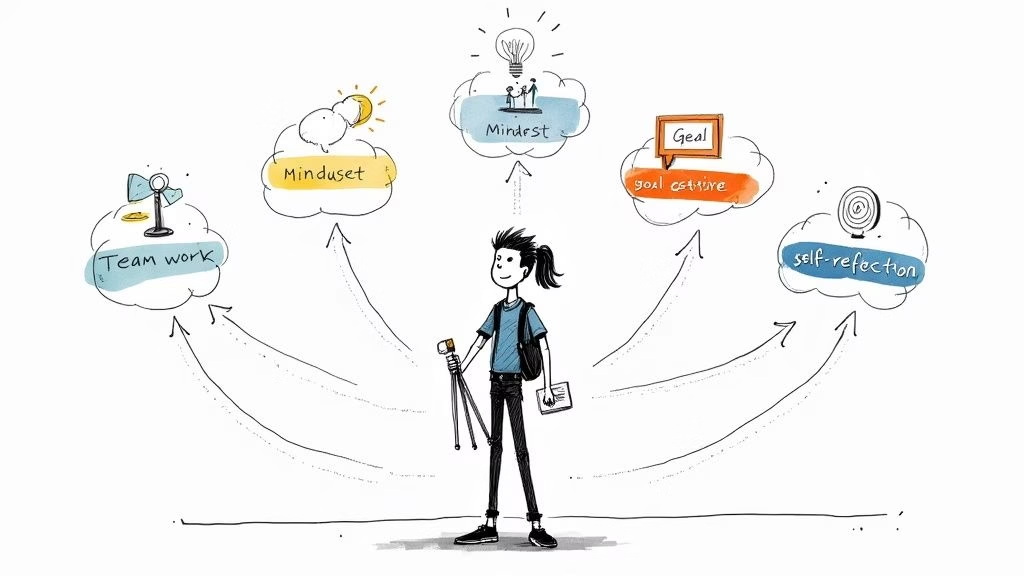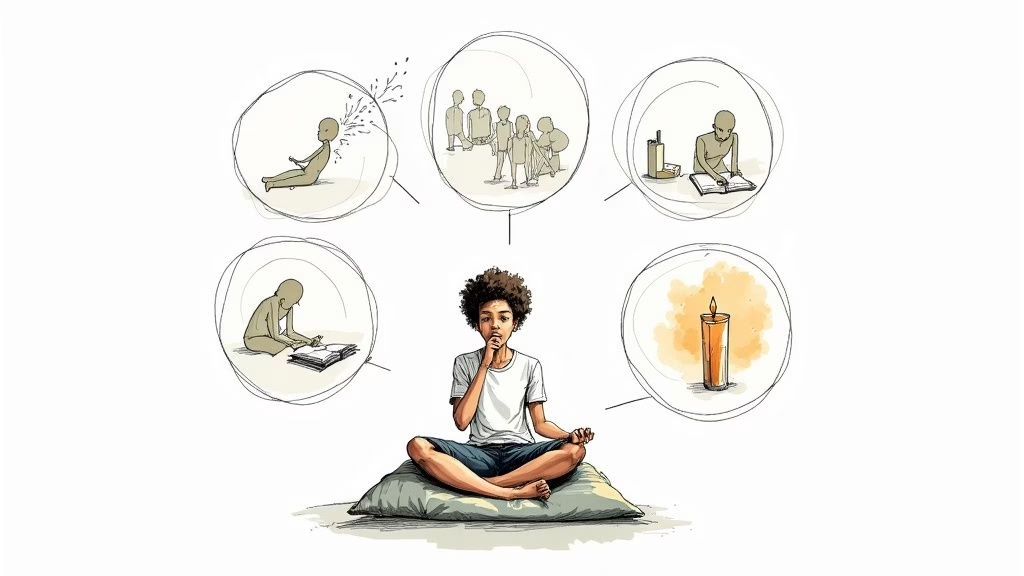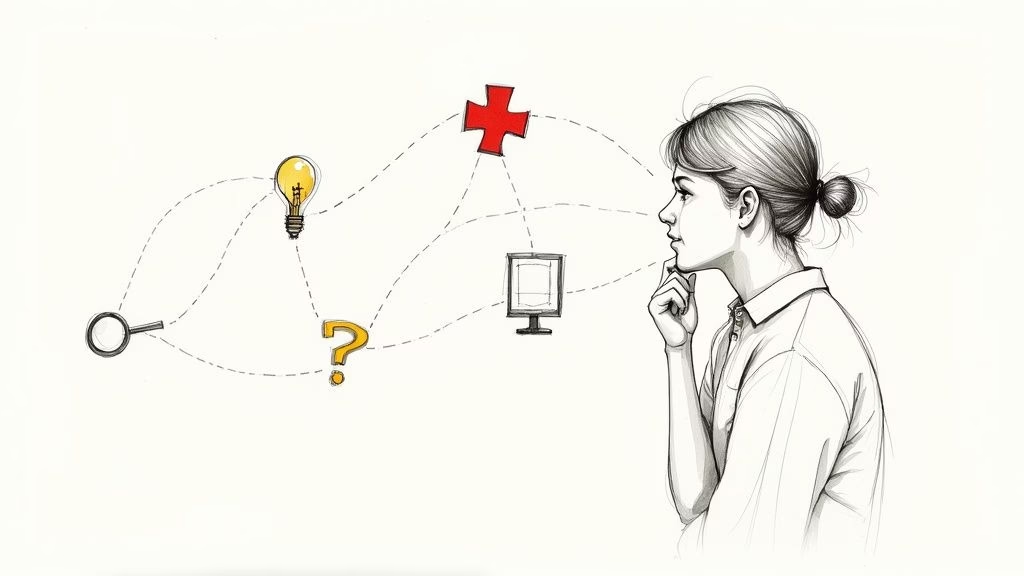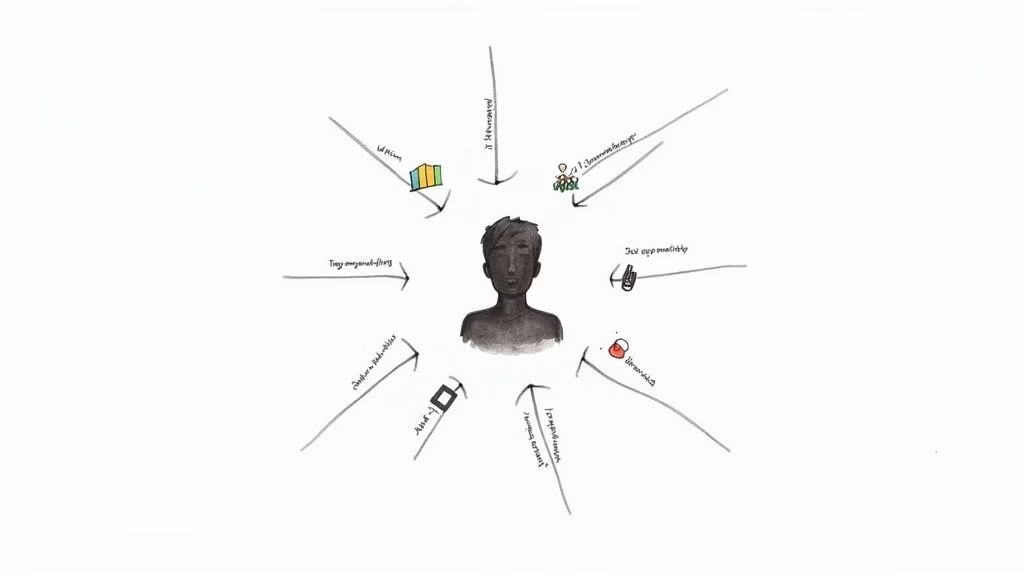To really get a handle on stress management for teens, we first have to understand why this time of life feels so intense. And let’s be clear: it’s not just in your head. The perfect storm of a still-developing brain, insane academic pressure, and a tricky social world creates a unique kind of stress that needs its own playbook.
Why Being a Teen Can Feel So Stressful
If you feel like life is dialed up to eleven right now, you're not wrong. Being a teenager today means navigating a level of pressure that past generations just didn't have to deal with. Getting a grip on where that stress comes from is the first real step toward managing it.
A huge piece of the puzzle is the teenage brain itself. Think of it like a brand-new, top-of-the-line computer with the fastest hardware, but the operating system is still in the middle of a massive update. The parts of your brain that handle gut reactions and big emotions (the amygdala) are firing on all cylinders. Meanwhile, the part responsible for thinking things through and planning ahead (the prefrontal cortex) is still under construction.
That imbalance makes it incredibly hard to keep your emotions in check. It's not a personal failing; it's just biology at work.
The Weight of Modern Pressures
On top of all that internal rewiring, you’re dealing with a whole new set of external pressures. For most teens, school is ground zero for stress. The constant push for good grades, the mountains of homework, and that looming anxiety about college applications can feel like carrying a heavy backpack 24/7.
And this isn't just a feeling—the data backs it up. The American Psychological Association found that teens actually report higher stress levels than adults do. On a 10-point scale, teens average a 5.8, while adults come in at 5.0. And a jaw-dropping 83% of teens say school is a major source of that stress. You can dive deeper into these teen stress statistics and their impact.
The reality is, the pressure is real and it's widespread.
This isn't just noise; it’s a clear signal that the vast majority of teens are feeling the squeeze, with school and social pressures leading the charge.
Identifying Your Personal Stress Triggers
While things like school and friendships are common stressors, everyone’s experience is unique. The real power comes from pinpointing exactly what pushes your buttons. Naming your triggers is the first step to disarming them.
To help you get started, here’s a breakdown of the most common sources of stress for teens today. See which ones resonate with you.
Common Stress Triggers for Modern Teens
| Stress Category | Common Examples |
|---|---|
| Academic Pressure | Exams, grades, homework overload, college applications, perfectionism |
| Social Relationships | Fitting in, peer pressure, friendships, romantic relationships, bullying |
| Family Issues | Parental expectations, sibling conflict, financial strain, family changes |
| Future Uncertainty | Choosing a career path, identity questions, fear of failure |
| Social Media | Constant comparison, cyberbullying, pressure to present a perfect image |
By looking at this list, you can start to connect the dots between what's happening in your life and how you're feeling.
The most important thing to remember is that your feelings are valid. The stress you're experiencing is a completely normal response to the intense biological and environmental pressures of being a teenager. Recognizing this isn't an excuse—it's empowerment. It's the foundation for building the skills you need to navigate it all.
How to Recognize the Sneaky Signs of Burnout
Stress isn’t always a big, dramatic meltdown like you see in the movies. Far more often, it’s a quiet, creeping exhaustion that slowly drains your battery until you feel completely spent. This is burnout, and spotting its sneaky signs is one of the most important skills you can develop for stress management for teens.
Think of it like a slow leak in a tire. You might not notice it at first, but over time, the tire gets softer and driving gets harder until you’re left completely flat. Learning to spot the leak early means you can patch it before you’re stranded on the side of the road.
Checking in on Your Physical Well-Being
Long before your mind fully registers what's happening, your body starts keeping score. These physical signals are your body’s early warning system, trying to get your attention and tell you that something is out of balance.
You might start getting more headaches than usual, or maybe your stomach is always upset for no clear reason. Chronic stress can also wreak havoc on your sleep. You might find yourself tossing and turning all night, or on the flip side, feeling exhausted no matter how many hours you sleep.
It's easy to brush off these physical aches and pains, but they’re actually important clues.
Decoding Your Emotional Signals
Stress also leaves its fingerprints all over your emotional state. One of the clearest signs is a short fuse. If you find yourself snapping at friends or family over tiny things, it’s probably a sign that your emotional reserves are running dangerously low.
Another major red flag is pulling away from people. Maybe you’ve started dodging texts from your best friend or making excuses to skip things you used to love. This doesn’t make you a bad friend. It’s often a self-preservation tactic your brain uses when you feel too overwhelmed to connect with others, trying to conserve what little energy you have left.
Burnout isn't a sign of weakness; it's a sign you've been trying to be strong for too long. Recognizing this allows you to shift from self-criticism to self-compassion, which is the first step toward healing.
Spotting Changes in Your Behavior
Sometimes, the clearest signs of burnout show up in what you do—or don't do. Procrastination is a classic example. That history paper you keep putting off? It’s probably not laziness. It’s more likely that the anxiety around getting it done feels so huge that your brain’s only response is to avoid it altogether.
You might also notice you've lost motivation for the things you once enjoyed. If picking up your guitar or playing your favorite video game starts to feel like a chore instead of a fun escape, that’s a big deal. It shows that your mental exhaustion is spilling over into every part of your life, dimming your passions.
These shifts can be subtle, but they are powerful indicators that you need to take a step back. Understanding what's behind these behaviors is key, and if anxiety is a major factor, you can learn more about how to reduce anxiety.
By learning to perform these self-check-ins, you can catch burnout before it takes full control.
My Journey from Engineering Stress to Mindful Calm
Reading about stress management for teens is one thing. Seeing it work in the real world is another. I want to share my own story to show you just how powerful these tools can be, especially when academic pressure feels like it’s swallowing you whole.
During my undergrad engineering program, I was drowning. The workload was a relentless firehose of complex problem sets, high-stakes exams, and impossible deadlines. My days blurred into a mess of lectures and late-night study sessions, and my nights were filled with anxiety instead of sleep. I’d lie awake for hours, my mind racing, replaying formulas and worrying about the next day’s assignments.
I was living in a constant state of fight-or-flight, always on edge, feeling like I was one bad grade away from a full-blown panic. The pressure I put on myself to succeed was crushing me, and it was taking a serious toll on my mental and physical health. My motivation hit rock bottom, procrastination became my go-to coping mechanism, and I felt completely disconnected from myself.
The Search for an Anchor
I knew something had to give. I started looking for ways to cope and stumbled on the idea of mindfulness. At first, I was skeptical. The idea of sitting silently in a room seemed impossible for someone with a mind as chaotic as mine. But I quickly learned that mindfulness wasn't about emptying my head; it was about getting back into my body.
I decided to try a different approach—something active and engaging. For me, that came in three forms: yoga, indoor rock climbing, and simple meditation. I made a small, manageable commitment: just 10 minutes a day.
That short daily practice became my anchor in a sea of academic chaos.
My breakthrough came when I realized that managing stress wasn't about eliminating it. It was about building small, consistent habits that gave me a sense of control and grounded me in the present moment, even when everything else felt out of control.
How 10 Minutes Changed Everything
Each activity gave me a unique kind of relief. Indoor rock climbing was a physical puzzle that demanded my full attention. When I was on that wall, there was no room to worry about calculus or circuit analysis. My mind was forced into the present, focused only on the next handhold, the next move. It was an intense, meditative experience that silenced all the academic noise.
Yoga taught me something different but just as valuable: the power of connecting my breath to my movement. As I flowed through the poses, I learned to tune into my inhales and exhales, which had a profoundly calming effect on my racing thoughts. It was like turning down the volume on my anxiety. This simple act of breathing with intention helped regulate my nervous system and brought a sense of peace I hadn't felt in years.
Even just a few minutes of quiet meditation before bed made a huge difference. Instead of spiraling into worry, I could gently guide my mind back to the present.
From Surviving to Thriving
The results were astonishing. Within a few weeks of starting my 10-minute daily routine, I was sleeping through the night again. Waking up rested gave me the mental energy to tackle my coursework with a new focus. Before an intense study session or a big exam, I'd take a few moments to ground myself with deep breathing. That small pause gave me the clarity I needed to perform at my best.
These practices didn't just help me survive my engineering degree; they helped me thrive. I learned how to manage my motivation, beat procrastination by breaking down my stress, and approach my studies with a calmer, more resilient mindset. My story is proof that you don't need hours of free time to make a real change. A few minutes of intentional, mindful activity can be the key to unlocking your own sense of calm and control.
Building Your Practical Stress Management Toolkit
Knowing your stress triggers is the first step. Now it’s time to actually build your toolkit—a collection of go-to strategies you can pull out whenever you need them. Think of these as your first-aid kit for handling everything from a sudden wave of panic before a presentation to the slow, creeping pressure of a packed school week.
Real stress management for teens isn't about finding one magic bullet. It’s about having a few different tools you can rely on, so you can pick the right one for the moment.
In-the-Moment Stress Busters
These are your emergency techniques for when stress hits you hard and fast. They're designed to pull you out of your head and back into the present moment, calming your nervous system when you feel like you’re spinning out.
One of the most powerful and discreet tools you can use anywhere is the 5-4-3-2-1 grounding technique. It works by forcing your brain to focus on your immediate surroundings instead of the anxious thoughts spiraling inside.
Here’s how to do it:
- See 5 things: Look around and name five things you can see. Notice small details—the grain on your desk, a scuff on your shoe, the way light hits the wall.
- Hear 4 things: Tune into the sounds around you. The hum of a light, distant traffic, your own breathing, the clicking of a keyboard.
- Feel 3 things: Focus on physical sensations. Feel your feet on the floor, the texture of your jeans, the cool surface of your phone in your hand.
- Smell 2 things: What can you smell? Maybe it’s a nearby coffee, the pages of a book, or just the air in the room.
- Taste 1 thing: Bring your attention to one thing you can taste. It could be the lingering taste of your lunch, a sip of water, or the mint from your gum.
This simple exercise breaks the panic cycle by engaging all your senses, offering immediate relief.
Proactive Habit Builders
While grounding techniques are great for emergencies, building long-term resilience means creating consistent, healthy habits. These are the things you do proactively to manage stress before it takes over, making you less vulnerable to it in the first place.
A great place to start is with journaling. You don't have to write a novel. Just spending five minutes jotting down your thoughts gets them out of your head, which can make your worries feel a lot more manageable.
Another powerful habit is scheduling "worry time." Seriously. Set aside a specific 10-15 minute window each day just to think about your anxieties. This contains your worries to a single time slot, so they don’t follow you around all day.
Globally, this stuff matters. The World Health Organization estimates that one in seven individuals aged 10-19 years struggles with mental health conditions. Anxiety and depression are at the top of the list, and many of these issues go unrecognized. This is exactly why learning proactive coping skills is so critical. You can learn more about the research on adolescent mental health.
The goal isn't to eliminate stress but to build a strong foundation of healthy habits. Think of it like training for a sport; consistent practice makes you stronger and better prepared for game day.
Powerful Mindset Shifts
How you think about stress, school, and success shapes how you experience it. A simple shift in your mindset can be a game-changer. For many teens, the biggest mental trap is perfectionism—the idea that anything less than perfect is a total failure.
To break free, you have to challenge that belief by embracing a "good enough" mindset. Instead of aiming for 100% on every single thing, focus on your effort and progress. Remind yourself that mistakes are how you learn, not a sign that you aren't good enough. This one shift can dramatically lower the pressure you put on yourself, freeing up mental space and cutting down school-related anxiety.
Tips for Parents How to Help
Parents, you can play a huge role here. You can't do the work for your teen, but you can create an environment that supports them as they build their own toolkit.
- Model Healthy Coping: Your teen is watching. Let them see you manage your own stress in a positive way, whether it's by going for a walk after a tough day or talking through a problem out loud.
- Listen Without Fixing: Sometimes, they just need to vent. Try to listen without immediately jumping in with solutions. Just validating their feelings—saying "that sounds really tough"—can make a world of difference.
- Encourage Balance: Help your teen protect their downtime. A schedule that makes room for rest, fun, and hobbies is one of the best defenses against burnout and the stress that comes from school and procrastination.
How to Tackle School Stress and Procrastination
For a lot of teens, "stress" and "school" might as well be the same word. The endless loop of homework, pop quizzes, and the constant pressure to pull good grades can feel like carrying a backpack full of rocks. That weight often triggers a familiar defense mechanism: procrastination. It might look like laziness on the surface, but it's something much deeper.
Procrastination isn't a personality trait; it’s your brain’s way of hitting the brakes when it feels overwhelmed. When an essay or a big project feels like too much, your mind naturally wants to sidestep the anxiety that comes with it. This kicks off a nasty cycle: you put it off, the deadline creeps closer, your stress skyrockets, and now the task feels even more impossible. Learning to break that cycle is a huge part of stress management for teens.
This cycle is more common than ever, with teen anxiety on the rise. Research shows that as many as one in three teens might develop an anxiety disorder before they turn 18. Between 2009 and 2019 alone, the number of high school students who reported feeling persistently sad or hopeless shot up from 26% to over 37%. Academic pressure is a huge piece of that puzzle. You can read the full research on adolescent anxiety to see the trends for yourself.
Overcoming Procrastination with Micro-Tasks
One of the best ways to get out of your own way is to make a task feel less scary. This is where breaking down big projects into tiny, manageable "micro-tasks" can be a total game-changer. Instead of putting "write my history essay" on your to-do list, your first step becomes "open a new document and write a title." That’s it.
By focusing on ridiculously small, achievable steps, you lower the emotional hurdle that keeps you from starting. Each tiny task you check off gives you a little hit of accomplishment, which builds the momentum you need to tackle the next one. This strategy turns a mountain of stress into a series of small, easy-to-climb hills. For a deeper look at building better study habits, check out our guide on time management for students.
Building Focus with the Pomodoro Technique
Okay, so you’ve started. Now what? The next challenge is staying focused. The Pomodoro Technique is a ridiculously simple but powerful way to train your brain to concentrate in short, intense bursts. It breaks your study time into focused sprints.
Here’s how it works:
- Set a timer for 25 minutes and work on one single thing. No phone, no distractions.
- When the timer dings, take a 5-minute break. Get up, stretch, grab a snack, do anything but work.
- After you've done four of these "Pomodoros," take a longer break—about 15-30 minutes.
This method keeps you from burning out and makes studying feel less like a never-ending marathon. It teaches your brain how to focus and shows you just how much you can get done in short, dedicated chunks of time.
My Personal Battle with Academic Stress
I know exactly how crushing school pressure can feel because I’ve been there. During my engineering undergrad, I was drowning in stress. The workload felt insane, and I was caught in a cycle of sleepless nights, procrastination, and feeling like I was one bad test score away from a total meltdown. I knew I had to find a way to ground myself.
My solution was mindfulness—and no, I don't mean sitting in a silent room for hours. For me, it was about reconnecting with my body for just 10 minutes a day. I got into yoga, indoor rock climbing, and simple meditation. Climbing forced my brain to shut up and focus only on the next handhold, silencing all the academic noise. Yoga taught me to connect my breath with my movements, which immediately calmed my racing thoughts.
Just 10 minutes of coming into my body each day helped me sleep better at night and grounded me before I started studying. It was my anchor, giving me the mental clarity to not just survive the pressure, but to prepare for my work and actually perform well. This small commitment made a massive difference in managing my motivation and breaking the procrastination cycle.
How Parents Can Support Their Teen
Watching your kid struggle with stress can make you feel completely helpless. You can’t take their exams for them or fix their friendship drama, but your role as their ally is more powerful than you might think. Creating a supportive home environment is one of the biggest factors in stress management for teens, and it all starts with how you listen and respond.
Your first instinct might be to jump in with a solution, to "fix" whatever is wrong. But most of the time, teens just need to be heard. They don't need answers; they need to know you're listening.
When they decide to open up, practice active listening. That means putting your phone away, making eye contact, and giving them your full, uninterrupted attention. The goal is to validate what they’re feeling, not dismiss it. Simple phrases like, "That sounds incredibly frustrating," or "I can see why you're so worried about that," show you're on their side. That small act of validation builds trust and keeps the door open for future conversations.
Model How to Handle Stress Well
Teens learn a ton just by watching the adults in their lives. You’re their primary role model for handling pressure. When they see you manage your own stress in a healthy way, they learn that it’s possible for them, too.
- Talk Through Your Own Stress: Instead of bottling things up, talk about your feelings in an age-appropriate way. For example, saying, "I have a huge deadline at work and I'm feeling a bit overwhelmed, so I'm going to take a walk to clear my head," shows them a positive coping mechanism in real-time.
- Prioritize Your Own Well-being: Let them see you make time for rest, hobbies, or exercise. It teaches them that self-care isn't selfish—it's a necessary part of a balanced life.
- Embrace Imperfection: Show them that mistakes are learning opportunities, not failures. When you handle a setback with resilience, you teach them that it’s okay not to be perfect.
This approach makes stress feel like a normal part of life and gives them a practical blueprint for how to deal with it.
Your greatest tool is creating a home where it’s safe to be stressed. When teens know they can talk about their struggles without judgment or panic, they are far more likely to ask for help when they truly need it.
Practical Steps to Support Your Teen
Beyond emotional support, you can help structure their environment to cut down on unnecessary stress. This means working with them to build routines that protect their mental and physical health, especially around school pressures.
Encourage a balanced schedule that includes non-negotiable downtime. Teens need unstructured time to just relax and recharge, free from the constant pressure of academics or extracurriculars.
Protecting their sleep is also vital. Research consistently shows that teenagers need nine to ten hours of sleep a night, yet most get nowhere near that. A lack of sleep directly craters their ability to handle even minor daily stressors.
It's also important to recognize when stress might be turning into something more serious, like anxiety. Understanding the signs is key. If you notice persistent changes in their mood, sleep, or behavior, it might be time to get professional support from a school counselor or therapist. For more on this, our guide on how to help a teenager with anxiety can offer more insight.
Frequently Asked Questions About Teen Stress
Trying to understand teenage stress can feel overwhelming for both teens and parents. It brings up a lot of questions. Let's break down some of the most common ones to give you a bit more clarity and support.
What Are the Most Common Stressors for Teens?
Every teen is different, but the big stressors usually fall into a few familiar buckets. School is a huge one—grades, endless homework, and the pressure of college applications can feel like a heavy weight.
Then there's the social side of things: trying to fit in, dealing with peer pressure, and navigating friendship drama. Add in family conflict, worrying about the future, and the constant comparison trap of social media, and it’s a perfect storm. Pinpointing these specific triggers is the first real step toward getting a handle on them.
How Can Parents Best Support Their Teens?
As a parent, you can be your teen’s greatest ally in this. The best thing you can do is just listen—without jumping in to "fix" everything right away. Simply validating their feelings and creating a safe, judgment-free zone for them to talk makes a world of difference.
Another powerful move? Model healthy coping skills yourself. When you manage your own stress in a constructive way, you’re giving them a real-life example to follow. You can also help them build a schedule that carves out non-negotiable time for rest, sleep, and just being a kid. It’s a practical way to lighten their load.
When Should a Teen Seek Professional Help?
It’s time to call in for backup when stress starts getting in the way of everyday life. If your teen is dealing with persistent sadness or anxiety, if their sleep or eating habits have changed dramatically, or if they’ve lost interest in things they used to love, it’s a clear sign they need more support.
Reaching for unhealthy coping mechanisms, like substance use, is another major red flag. A therapist, school counselor, or a life coach can offer specific tools and strategies to help them work through these challenges. For immediate, peer-based support, resources like Teen Line (1-800-852-8336) are there to help.
My own journey through engineering school taught me that managing stress isn't about eliminating it, but about building small, consistent habits. Activities like yoga, climbing, and meditation—just 10 minutes a day—were my anchor. They helped me get back into my body, quiet the mental noise, and prepare for my work. This small daily commitment made a huge difference in my sleep, motivation, and ability to handle academic pressure.
This proves that even brief, mindful activities can build powerful resilience against procrastination and school-related stress. The key is finding what grounds you and making it a non-negotiable part of your routine.
If your teen is struggling to turn overwhelm into action, Andrew Petrillo Life Coaching offers personalized, one-on-one coaching to build the skills they need to succeed. Learn more about how we empower teens to manage stress, improve motivation, and confidently navigate their future at https://andrewpetrillolifecoaching.com.






